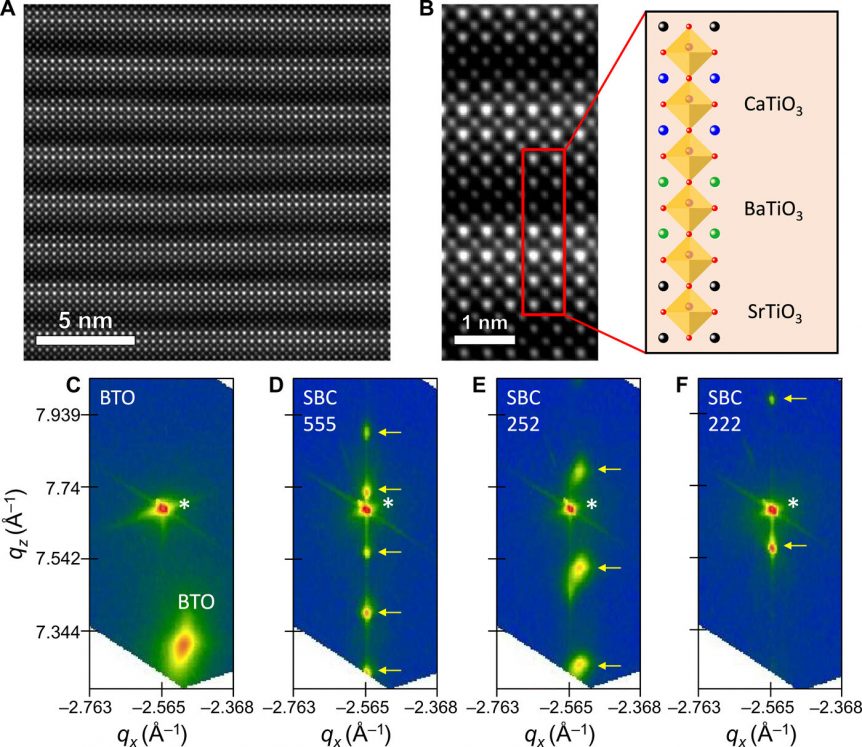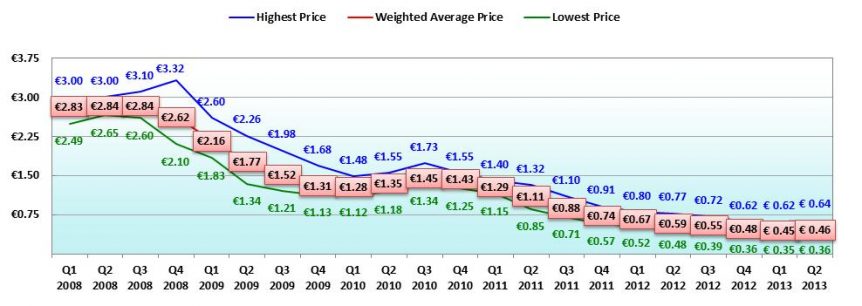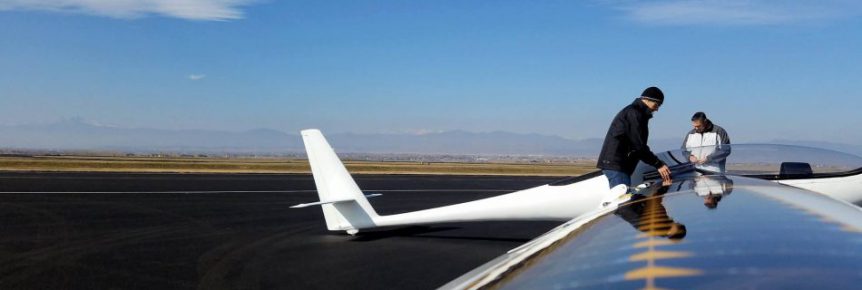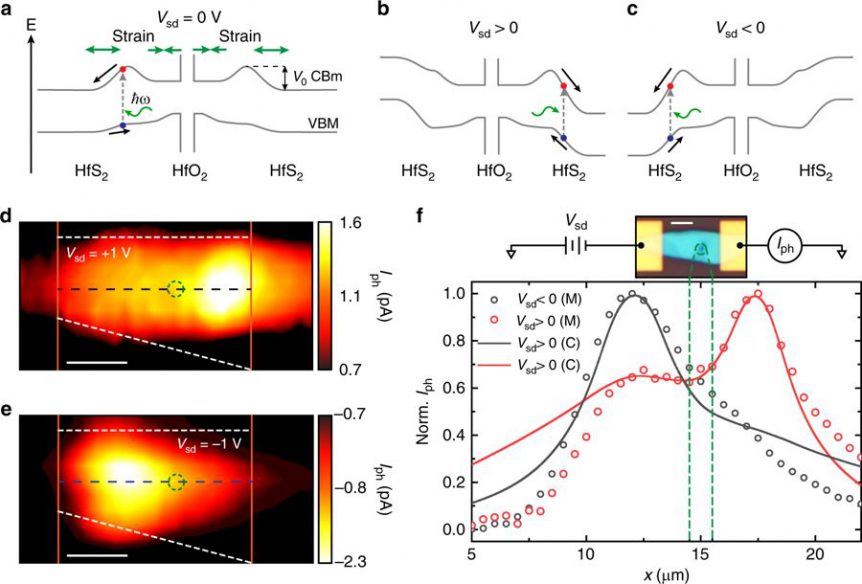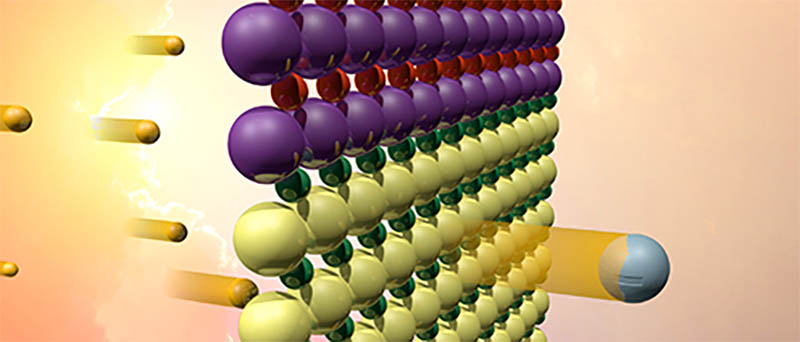We hear a lot about 10X batteries, but 1000X solar cells? Layering up may be stylish and even practical in the fashion world, and in solar cells may be a chance to unite otherwise dissimilar materials with otherwise limited light-to-electric conversion capabilities. That strategy produced solar cells with 1000x that. That’s what researchers at Martin Luther University Halle-Wittenberg (MLU) found when they created crystalline layers of layers of barium titanate (a mixed oxide of barium and titanium), strontium titanate and calcium titanate which they alternately placed on top of one another. Researchers found high increases in responses from the layered oxides because of higher permittivity – electrons able to flow more freely. The team’s paper, “Strongly enhanced and tunable photovoltaic effect in ferroelectric-paraelectric superlattices,” appears in the June 2 issue of the journal Science Advances. A Titanate Sandwich Barium titanate (BaTiO3 or BTO) is a “common ferroelectric material” used to manufacture electronic components such as capacitors. It is, “a popular …
Black-silicon Cell Efficiency above 130 Percent
Aalto University in Espoo, Finland has announced a seemingly impossible breakthrough – black-silicon solar cells that exceed 100-percent efficiency. This breaks the Shockley-Queisser limit, previously thought to be an unbreakable barrier to any solar cell generating more than 33.7-percent efficiency for a single p-n junction photovoltaic cell. The 1,000 Watts of sunlight falling on a square meter of single-junction solar cells could never produce more than 337 Watts to a battery or other receiving mechanism. William Shockley, a co-winner of the Nobel Prize in Physics for his co-creation of the transistor and Hans-Joachim Queisser defined this limit at Shockley Semiconductor in 1961. In a traditional solid-state semiconductor such as silicon, a solar cell is made from two doped crystals. One is an n-type semiconductor, which has extra free electrons, and the other a p-type semiconductor, which is lacking free electrons, referred to as “holes.” When initially placed in contact with each other, some of the electrons in the n-type portion will flow into the p-type to “fill in” the missing …
Ironing Out Cheap Molecules for Solar Panels
Making a Designer Iron Molecule To make more affordable solar cells, researchers at Sweden’s Lund University are not just trying to be cheap, they are avoiding tightening markets in expensive noble metals like ruthenium, osmium and iridium. A more common metal such as iron, constituting six percent of the earth’s crust, might just be the answer to several issues. One problem keeps it from being a great solar cell component. Iron just doesn’t take a shine to solar radiation. In the careful words of the abstract for the research team’s paper, iron’s shortcoming is exposed. “However, the photoexcitable charge-transfer (CT) states of most Fe complexes are limited by picosecond or sub-picosecond deactivation through low-lying metal centered (MC) states, resulting in inefficient electron transfer reactivity and complete lack of photoluminescence.” In other words, ordinary iron is just a flash in the pan when light strikes it and doesn’t kick any electrons around – not great behavior for solar cells. Chemistry Professor …
“StratoAirNet” Prototype Completes 1st Flight
George E. Bye. CEO and founder of Bye Aerospace, is on a roll these days, selling a large number of SunFlyer 2 training aircraft, delivering Silent Falcon solar electric unmanned aerial vehicles (UAVs), partnering in the TriFan 600 project with XTI Aircraft, and overseeing the first flight of the StratoAirNet prototype. A letter from Diane Simard, Senior Vice President of Bye Aerospace, Inc., reports “the successful completion of the first flight of the solar electric technology demonstrator prototype for its “StratoAirNet” and “Solesa” families of medium-altitude aircraft systems.” Flying from the Northern Colorado Regional Airport, north of Loveland, the sailplane-based optionally-piloted vehicle has made additional flights since its maiden outing. Bye expressed happiness at the event and gave thanks to those who made it possible. “It was a great day for solar-electric aviation. My thanks to our entire team for their persistence and extra efforts to achieve this milestone. I would also like to thank the professionals at Northern Colorado …
Funneling Light and Energy with New Materials
Dr. Adolfo De Sanctis, a Research Fellow in the Quantum Systems and Nanomaterials group at the University of Exeter (UK), earned his Ph. D. in physics with a dissertation on “Manipulating light in two-dimensional layered materials” (Nature Communications, May 2017). The video below gives a short-hand view of his work. Other, less scholarly outlets (like this one) give an easy-to-read view of what he has accomplished, and why his research is of interest for many applications – including energy harvesting. Green Optimistic reports, “A team of researchers from the University of Exeter developed a solar cell with a record 60% efficiency. The idea behind this breakthrough is similar to using a ‘funnel’: corralling an amorphous collection of electrical charges into a more precise area, where they can be transferred into use. Using this idea, the researchers increased the efficiency of a solar cell from 20 to 60 percent. The Exeter team sees their research as a ‘gateway’ for further research …
Bouncing Light Around Between Electrons and Holes
Bob Elliott of the comedy team Bob and Ray died February 3, reminding your editor of one of the many routines Elliott and Ray Goulding performed on live radio. It involved an inventor who had perfected a solar panel that could run the lights in your house all day, but couldn’t keep them going at night when they were really needed. That was over 50 years ago, and investigators at the Pacific Northwest National Laboratory, Argonne National Laboratory, SuperSTEM, and the University of Oxford have come up with a possible solution to Bob and Ray’s quandary. Combining two oxides, one containing strontium and titanium (SrTiO3) and the other lanthanum and chromium (LaCrO3), they came up with a material that uses the interface between the two oxides to absorb visible light and produce electrons (negative charges) and holes (positive charges), which might be “useful for catalyzing reactions, such as producing hydrogen fuel.” The oxides have to be kept apart, though, because otherwise, “they …
Solar Impulse Passes Midway Islands
With the sun soon to rise in the Pacific, Solar Impulse 2 continues scooting at over 60 mph toward Honolulu as the third night comes to an end. Significantly, Andre’ Borschberg and the 747-size plane have made it past the Midway Islands, once a stop-over for Pan-Am Boeing 314 “China Clippers.” Even with their 3,500-mile range, those luxurious planes needed a fueling stop mid-way between Hawaii and China or Guam. The islands were important enough as a way station in the vast Pacific that one of the largest and most decisive battles of World War II took place near them. In a battle terrible destructive to both sides, U. S. forces sank four Japanese carriers, essentially casting the fate of the remaining battles. The still-important role of the islands as emergency landing sites was reinforced in 2014 with the safe arrival of a Boeing 777 following “an odor” and failure of radar and other electronic systems. The idea of a …
Layering Astonishingly Light Materials to Make Electricity from Light
Researchers at the Vienna University of Technology have combined two semiconductor materials, each only three atomic layers thick. Adding one semiconducting layer of the photoactive crystal tungsten diselenide to a layer of molybdenum disulphide, and “creating a designer-material that may be used in future low-cost solar cells.” Having worked with graphene, that two-dimensional, atom-thick material that promises much for structures, batteries and solar cells, Thomas Mueuller, assistant professor of photonics, and his team “acquired the necessary know-how to handle, analyze and improve ultra-thin layers by working with graphene.” The team applied their lessons learned with graphene to combining two ultra-thin semiconductor layers and are now studying their optoelectronic properties. Mueller explains, ““Quite often, two-dimensional crystals have electronic properties that are completely different from those of thicker layers of the same material.” In their present study, the Tungsten diselenide, a semiconductor consisting of three atomic layers; one layer of tungsten sandwiched between two layers of selenium atoms. Mueller adds, “We had …
Ohio State’s Solar-Air Potassium Battery
Ohio State University researchers have come up with a two-in-one solar cell/battery combination that promises great efficiency and low costs. What’s not to like? Unfortunately for readers of the blog, it’s initially only a stationary system that will make energy storage a viable circumstance for large power plants, but it seems that the technology could be adapted to lighter, portable applications, such as electric vehicles. Ohio State is keeping somewhat mum about the patent-pending device, which they are developing as a commercial entity under the auspices of their spin-off, Kair (K for potassium, plus air and pronounced “care”). We’ve heard a great deal about upcoming lithium-air batteries, but potassium-air is unique. Even more unique, this battery stores energy from its own solar cell, the world’s first solar battery. A mesh solar panel allows air to enter the battery, and a special process transfers “electrons between the solar panel and the battery electrode. Inside the device, light and oxygen enable different …
Trapping Light: A “Perfect” Solar Absorber?
The news item from David L. Chandler at the Massachusetts Institute of Technology (MIT) claims that researchers there have come close to realizing the “ideal” for solar absorption, trapping and containing all of light’s wavelengths that reach earth’s surface from the sun. This absorbed sunlight is converted to heat by a two-dimensional metallic dialectric photonic crystal, which can absorb sunlight from a wide range of angles and withstand extremely high temperatures. Even better, it can be made cheaply and in large quantities, according to MIT. One aspect of the design that might make it difficult to use on aircraft is its high operating temperature. A solar-thermophotovoltaic (STVP) device, the energy from the sunlight hitting the cells is “first converted to heat, which then causes the material to glow, emitting light that can, in turn, be converted to an electric current.” Having worked on an earlier version of STVPs, the researchers noted that the solar cells had many hollow cavities. Nature …

